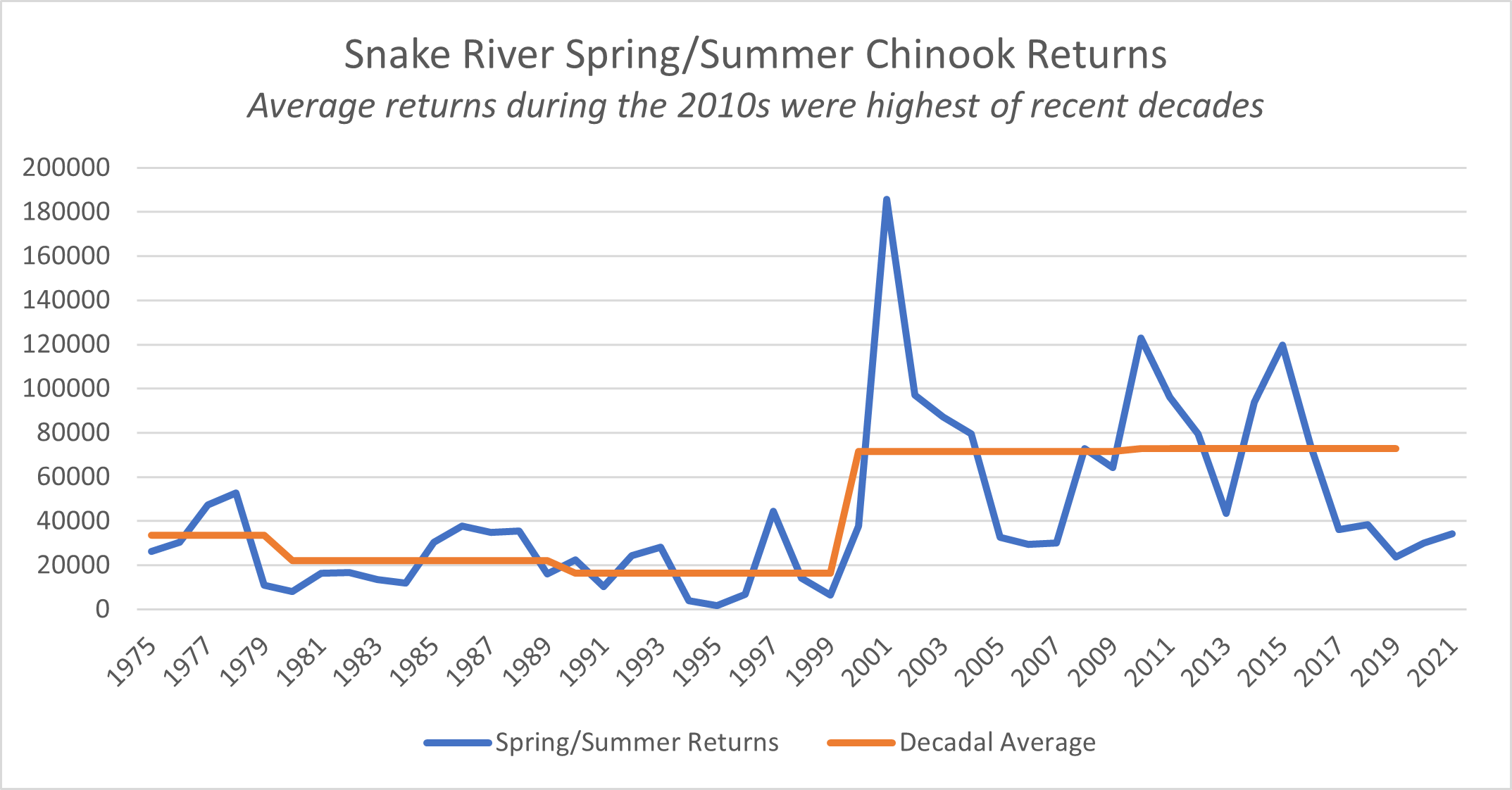Across the Pacific Northwest, salmon populations are struggling and need more resources and attention to help restore healthy numbers. Despite that reality, virtually all of the political attention is focused on the Snake River and proposals to lavish tens of billions of dollars to destroy four dams, even as salmon recovery efforts in other ecosystems are underfunded. That emphasis on destroying dams is counterproductive myopia.
Newspaper columnist Shawn Vestal is not happy that I have highlighted the repeated errors of those who advocate destroying the Snake River dams, pointing out that salmon returns have begun to rebound after a downturn. In his recent column he accused me of making “dishonest, disingenuous, and unscientific arguments about salmon returns.” He makes several errors, including the most basic – failing to understand my argument – in part due to his botched and half-hearted attempt to contact me, which resulted in a retraction of part of his column.
His piece is misinformed, hypocritical, and contradictory. Here’s why.
The Snake River and Northwest salmon runs
Before I describe the problems with Vestal’s column, it is worthwhile to outline the Washington Policy Center position on the Snake River dams and salmon runs. It is clear that Snake River Spring/Summer Chinook populations are in trouble. I have made this point repeatedly, notably on ABC News earlier this year. They noted that I believe, “the spring chinook are in crisis, but so are many other salmon runs across the Pacific Northwest.” I also agree with dam opponents that, in theory, destroying the dams would increase salmon returns “in the longer term.” It is also true, though, that the environmental analysis completed by the relevant federal agencies show salmon populations will increase anyway, albeit more slowly, even if we keep the dams.
The key question for those who want to destroy the dams is how much it will cost to gain that marginal improvement in the speed of a recovery. They refuse to answer that question. But avoiding the question of how we spend the limited resources of the state and federal government to improve salmon recovery is irresponsible, as I wrote last year.
Those who want to destroy the dams must explain why it is worth spending $33.5 billion to tear down the dams and lose carbon-free power to increase returns “in the longer term,” while we currently spend only about $100 million a year on salmon recovery in the entire rest of the state. It makes no sense, especially when we account for the other economic, human, and environmental costs of destroying the dams.
Our true position could have been discovered by Shawn had he bothered to look. He did not. The result is that his ill-informed attack misses the mark badly.
Short term trends are “extremely misleading”
Vestal’s first critique is that I inappropriately focus on short-term trends when I point out increases in Spring Chinook returns over the past two years. In the email he says he tried to send me, he wrote that Michelle DeHart, who runs the Fish Passage Center that counts salmon in the Columbia River Basin, “particularly criticized the lack of historical context, in which small increases in the returns at one dam exist in a long-term pattern of dramatic decline.” DeHart went on to say, “Mr. Myers has omitted major portions of historic facts and therefore presents conclusions that are not true.”
This complaint is both inaccurate and ironic.
I agree that looking at only a few years can be misleading. This is a point I have made repeatedly. In 2019, when Spring Chinook returns were at their lowest, I co-authored an op-ed with Governor Inslee’s former salmon advisor Steve Martin, in which we noted, “Some people point to low runs in 2019 on the Snake as evidence that we need to remove the dams. Salmon populations run in a cycle, however, and we are seeing the same low runs across the region.”
I repeated that point earlier this year, even before knowing the final Spring Chinook returns on the Snake. In a letter to the Lewiston Tribune, I wrote, “Chinook runs are cyclical, with declines in some years followed by significant increases.” Focusing on a few years, rather than looking at the cycle of returns gives an inaccurate view of the overall trend.
We are seeing the cycle play out exactly as I predicted in 2019. Since then, we have seen increases in Spring Chinook returns of 55 percent in 2020 and 27 percent in 2021. Those numbers are important not because they stand alone but because they fit the long-term pattern.
By way of contrast, dam opponents are the ones who focus on individual years to make exaggerated and inaccurate claims about the real state of salmon populations on the Snake. Just weeks before my column that Shawn objected to, two environmental groups claimed in Shawn’s own newspaper that, “80% of wild spring chinook populations in the Snake River Basin will be nearing extinction by 2025.” They based this claim on “current trends” by which they meant the downturn of the three years leading up to 2019, not the two years of rising returns that followed. Additionally, the study they cited claimed Spring Chinook returns on the Snake would decline in 2021. That turned out to be wildly inaccurate. Returns increased by 27 percent.
Did Shawn attack those groups for focusing on short-term trends and ignoring the “historical context”? No. Does he attempt to explain why we should trust activists who can’t even get their projections correct in the same year they are occurring? No. It shows how dishonest this critique is. When short-term trends are useful, dam opponents point to them as evidence of collapse. When the numbers do not serve them, they complain about the lack of long-term context. That is pure hypocrisy.
Shawn even contradicts himself on this issue. In his article he quotes anti-dam activist Terry Holubitz saying that the recent increases are, “’a little bit of a blip’ in a decades-long decline.” In his never-sent email to me, on the other hand, he says that even with the increases of the last two years the returns, “still place the spring Chinook run well below the 10-year average.” This is correct. Why? Because the 10-year average Spring/Summer Chinook return of the 2010s was the highest in many decades. The reason the past two years of returns are still comparatively low is that the returns over the past ten years have been so much better, contradicting the claim of a decades-long decline.

Even as they claim salmon populations are declining, they use the fact of increased returns to minimize the population growth during the past two years. Without realizing it, Shawn contradicts himself.
Impact of the dams on salmon runs
Shawn’s next attack on me is the claim that I ignore the impact of dams on salmon runs, writing that it is “frankly surprising they [WPC] would attempt to argue the dams aren’t doing what they’re doing to salmon.” The evidence he provides is a claim in a letter signed by 68 “scientists” who argue that low smolt-to-adult return ratios (SARs) – i.e. the percentage of smolt that return to spawn years later – show the harm being done by the four Lower Snake River dams.
It is worth noting that many of the people signing this letter are the same activists who signed previous letters calling for the destruction of the dams. I have recounted my (unsuccessful) efforts to get one of the signatories to defend the data in a previous letter he had signed.
Vestal quotes one of the signatories saying that, “For the Snake River, SARs are only available up to 2018, but they are dismal year after year after year – mostly below 1% and occasionally, at best, above 1%.” By way of contrast, “In the John Day River, above three dams, wild steelhead SAR is 5% and wild chinook is 3.6%. In the Yakima River basin, above four dams, wild steelhead SAR is 4% and wild chinook is 2.5%.” Since both the Yakima and John Day rivers are downstream of the Snake, they argue that the additional four dams are the cause of the low SARs.
Those data are intentionally misleading. The reason dam opponents choose those two rivers is because they are the only ones that fit their narrative. The same data show that two rivers even farther downstream – the Warm Springs River and the Carson River – have lower SARs than the Snake River populations. If dams are the cause of low SARs, why do returning salmon that pass fewer dams have even worse return rates? The reason is that dams themselves are not the driving factor in the poor return rates.
This is why a peer-reviewed study of SARs across the Northwest first published in October 2020 concluded, “Within the Columbia River, the SARs of Snake River populations, often singled out as exemplars of poor survival, are unexceptional and in fact higher than estimates reported from many other regions of the west coast lacking dams.”
One of the authors of that research responded to the letter Vestal cited. Dr. David Warren Welch, who has a PhD in Oceanography, was blunt, arguing that, “It is mathematically impossible for removing the four Snake River dams to materially change salmon survival levels and it is long past time to make this clear to decision makers. Their letter also misrepresents the state of salmon runs in most other regions of the West Coast, which have similar conservation issues. In short, their three conclusions concerning removal of the Snake River dams as a fix for the salmon problems are just plain wrong.”
One can disagree with the arguments made by the people who signed the letter cited by Shawn or the research showing a region-wide problem with SARs. The typical rebuttal from non-scientists goes something like “I trust 68 people more than three,” as if the ability to collect more signatures trumps peer-reviewed research. At the very least, the authors of the letter cited by Vestal must explain why they picked only those two river systems, ignoring others where SARs are worse than in the Snake River. I have sent emails to two of the contacts provided for that letter asking exactly that question and I will share the answer when or if I receive it.
But what about…
I have limited myself to the arguments Vestal made in his piece. There will now be people who respond with, “but what about...” river temperatures/wild vs hatchery/orca/etc. I have addressed many of these issues elsewhere and people can do their own research into my already-stated position.
Even as dam opponents try to attack my data, they refuse to answer the key weaknesses of their own claims. The biggest problem with their insistence on destroying the dams, from my standpoint, is that we face a statewide problem with returning salmon. Narrowly focusing on one, extremely expensive policy is dangerous and risks underfunding salmon recovery efforts elsewhere.
Myopic focus on the Snake River is bad for salmon across the state
In fact, Vestal quotes Erik Neatherlin, the Executive Director of the governor’s Salmon Recovery Office, saying Washington’s salmon are, “teetering on the brink of extinction,” adding that, “Fourteen Washington salmon runs are listed as endangered.” This is exactly correct. Washington’s State of Salmon report for 2020 shows that the only Snake River run listed as being “in crisis” is the Spring/Summer Chinook run. By way of contrast, Puget Sound Chinook and steelhead both have that critical classification.
Additionally, the report notes that Snake River steelhead are “making progress,” and the recovery of Fall Chinook are “approaching goal,” one of only two listed runs in the state to achieve that level. While two of the three listed runs in the Snake are headed in the right direction, most other threatened runs in the state are struggling. Even as Vestal notes that reality, he seems to want to focus a massive amount of money on efforts that even dam opponents admit would pay off only in the long term.
In both of the past two state budgets, I have pushed for increased salmon recovery funding for the state. In 2019, I co-authored a piece in The Seattle Times with the chair of the Puget Sound Salmon Recovery Council calling on the state legislature and Governor to “fully fund salmon recovery.” Even at the slightly improved state funding level of just over $90 million per year, the $33.5 billion in federal money dam opponents want to destroy the dams and mitigate the other costs is equivalent to more than 300 years of state salmon recovery funding. Spending that money elsewhere – in the Columbia, in Puget Sound, etc. – would almost certainly provide a much greater benefit.

That’s why Vestal’s column isn’t just inaccurate and hypocritical. His column and arguments similar to it are likely to end up harming salmon recovery across the Northwest by irresponsibly focusing huge amounts of funding on an effort that offers limited benefit while doing little where it is more critical for salmon, orca and people who rely on strong salmon runs.






